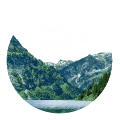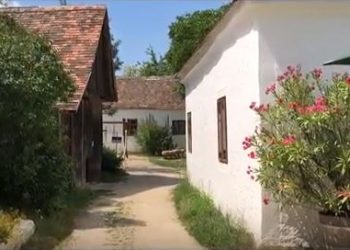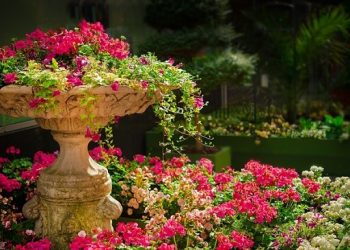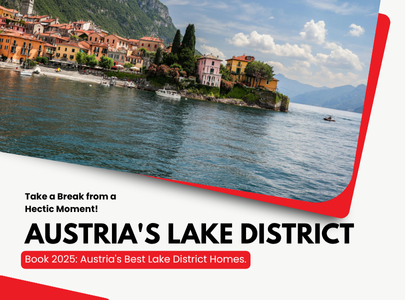In this article, we have compiled the most important information about Hainburg.
Table of Contents
- Hainburg – General Information
- Attractions within the Town
- Castle Hill (Schlossberg)
- Braunsberg Hill
- A Nice Place for Lunch
- Getting There by Public Transport from Vienna
- Traveling to Bratislava by Public Transport
- Additional Essential Information for Your Visit
- Other attractions in the area: Schloss Hof, Niederweiden Palace, Carnuntum, Bratislava, Devín
Hainburg – General Information
The town of Hainburg is located in the Bruck an der Leitha district of Lower Austria, right on the banks of the Danube River. It is a small and quiet place with only about 7,000 residents. Many visitors come from neighboring Slovakia, which is a short drive away – only 4 kilometers to Devín Castle and about 12 kilometers to the city of Bratislava. Vienna is 43 kilometers away from the town.
The first settlers in the Hainburg area were Illyrian tribes, followed by the Celts who settled on Braunsberg hill, which overlooks the entire region. During the Roman period, the town was under the control of the city of Carnuntum, which was the provincial capital at the time.
In 1050, the fortified castle of Hainburg was built by order of Emperor Henry III, ruler of the Holy Roman Empire. In the following centuries, the town became a fortified stronghold, surrounded by a 2.5-kilometer-long wall with about 15 watchtowers and fortified entrance gates.
The castle of Hainburg passed through several noble families and continued to expand, but a number of regional wars with the Hungarians and Ottomans brought it to ruin. Today, the castle stands desolate on the hilltop overlooking the town and serves as a nice place for a picnic or a viewpoint.
Interestingly, in the first half of the 18th century, the famous Joseph Haydn lived in Hainburg for a short time as a 6-year-old. In the town, he studied music and was part of the local boys’ choir. There is a fountain in his memory in the town center.
Attractions within the Town
There is no doubt that Hainburg has a long history, and its historic parts are visible in every corner of the town. The center of Hainburg, however, is not particularly impressive. There are a few small, ancient streets, but most of the town is modern and quite ordinary. The places that do leave a good impression are the old Vienna Gate and the central church. The Vienna Gate was built in the 13th century and is considered the largest surviving medieval gate in Europe. The town museum is located inside the gate’s structure.

The central church is located in the heart of the town, and its tower stands out on the skyline when viewing the town from above. It is an ancient medieval church that was renovated in the Baroque style.
Another nice spot in town is the promenade along the Danube. You can enjoy a pleasant walk or bike ride right on the riverbank.
On hot days, you can go for a swim at the local swimming pool, Bergbad. There are large lawns, a nice water slide, and various other activities like beach volleyball, minigolf, and more. Admission costs about €6 per person, but if you arrive in the afternoon, the price drops to just two euros.
For more information about the pool (in German), visit their website.
Address: Braunsbergstraße 3, 2410 Hainburg an der Donau
Besides these, there are two other recommended attractions to visit: Castle Hill and Braunsberg Hill, on which there is an ancient Celtic structure.
Castle Hill (Schlossberg)
On a wooded hill adjacent to the town are the ruins of the great Hainburg Castle. The walking trail to the castle starts right from the heart of the town, and the path up the hill is well-maintained and signposted. The walk takes about 20 minutes on a moderate incline through the forest.
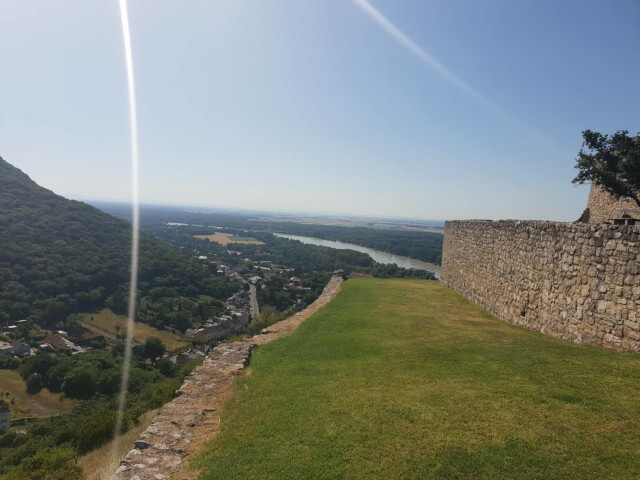
At the top of the hill is the castle, which is open to visitors free of charge. The castle grounds are well-kept, with lovely lawns and nice benches for resting. You can have an enjoyable picnic or simply enjoy the wonderful view of the Danube River and the town. On clear days, you can also see neighboring Bratislava. The descent back to the town is via the same path.
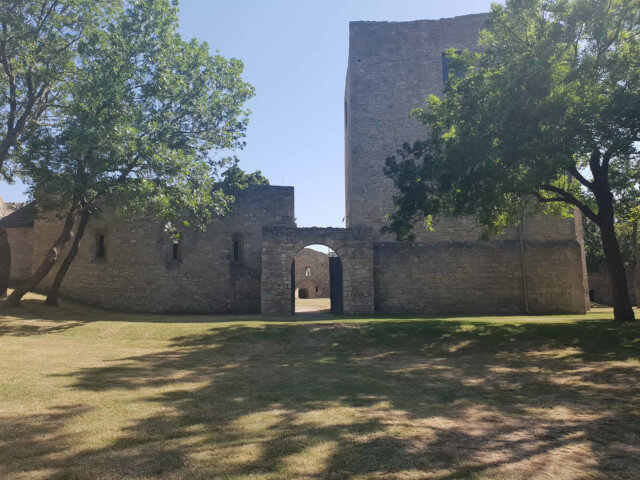
Braunsberg Hill
On the other side of the town is another hill, no less impressive than Castle Hill – Braunsberg Hill. This is a rocky, exposed hill that was once the settlement of the Illyrians and Celts. The walking trail starts near the municipal swimming pool. The path is signposted and clear. The uphill walk takes about 20 minutes. The trail is a bit “wilder” compared to the path to Castle Hill, but it is comfortable and easy to follow.

When you reach the top of the hill, a large, flat area opens up before you, offering a wonderful panoramic view of the entire region. You can look out over the town, the Danube River, the Donau-Auen National Park, Bratislava, and more.
There is also a nice wooden structure on the site where an ancient Celtic fortress once stood. The wooden structure serves as a great observation deck for the entire area.
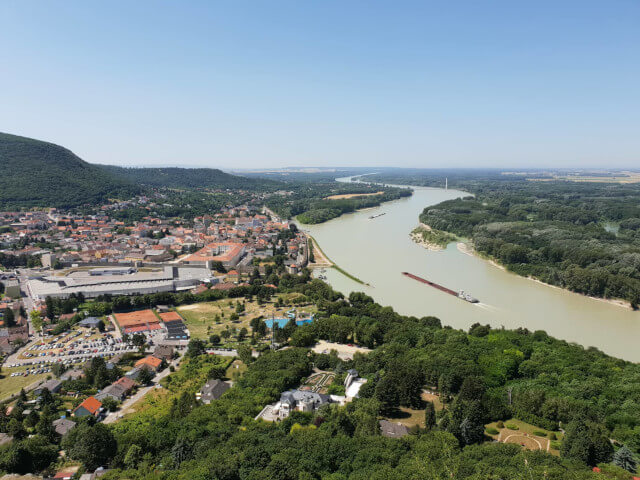
You can descend back to the town the same way you came or simply walk along the road that leads back to the town.
Lunch Break – A Recommended Restaurant
After the long walk and the wonderful views of the entire area, you can treat yourself to a delicious lunch at a local restaurant. A recommended restaurant is called Gasthaus zum Pressburger, run by a friendly Slovak family. The food is very tasty, and the prices are excellent compared to other restaurants in Hainburg.
Note that on Sundays, they close at 3:00 PM. On Fridays and Saturdays, they are open until 10:00 PM.
Address: Alte Poststraße 36, 2410 Hainburg an der Donau
Getting There by Public Transport from Vienna
The easiest way to get to Hainburg from Vienna is by train. The suburban train S7 runs from the center of Vienna to the center of Hainburg. You can take the train from the central Wien Mitte station and get off at the Hainburg Ungartor station. The journey takes about an hour and a quarter. A single adult ticket costs around €10.
You can plan your route using the official Austrian railway website’s route planner.
Traveling to Bratislava by Public Transport
If you wish, you can easily continue from Hainburg to Bratislava. Regional bus number 901 or 921 runs from Hainburg to the city center of Bratislava (Most SNP). The journey takes about twenty minutes, and the ticket costs one and a half euros. The bus arrives every hour.
For more information on the bus schedule, check their website.
Additional Essential Information for Your Visit
Address: Hainburg an der Donau
Map:
Other Attractions in the Hainburg Area
In the vicinity of the town, there are several attractions worth considering a visit when you are in the area. Within Austria, you can travel to the ancient Roman town of Carnuntum, which is nearby. You can reach Carnuntum on the same train that returns to Vienna. Carnuntum has a Roman archaeological site and an experiential museum for the whole family. Read more in our detailed article on Carnuntum.
Another attraction is the impressive Schloss Hof. This is a preserved historic palace with magnificent gardens and a wonderful view of the entire region. Nearby is the beautiful Niederweiden Palace, so you can combine it with your visit. Read more about these impressive palaces.
If you want to continue enjoying the nature of the area, you can walk along the trails in the Donau-Auen National Park. This is a huge park that eventually reaches Vienna. More information in our detailed article.
Of course, you can also continue towards Slovakia and stop at the wonderful Devín Castle, which is only 4 kilometers from Hainburg. This is a must-see attraction if you are in the Bratislava area. Its view and history are absolutely fantastic.
Another important attraction is, of course, the capital of Slovakia – Bratislava. The old town of Bratislava is very charming, and you can easily spend several hours there among the historic sites. On Sundays, when all the shops in Austria are closed, all the shops are open as usual in Bratislava, so you can even enjoy shopping in the many malls. Read more about Bratislava here.

